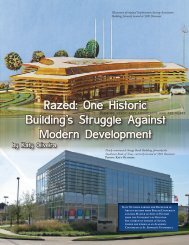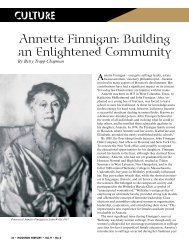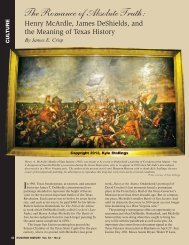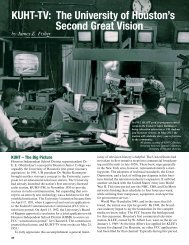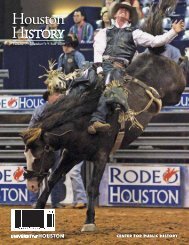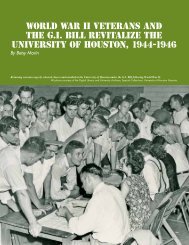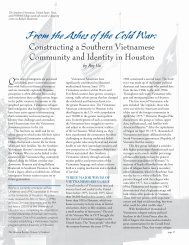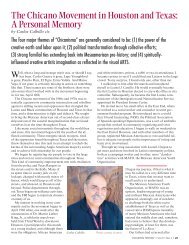THE FIRST PROMISING RUMOUR I heard about the HarrisCounty Domed Stadium was that it was going to be large enoughthat the Shamrock Hotel could be put inside it. Great, I thought—assuming, naturally, that the powers that be would take advantageof such an opportunity. At last a real solution to the Shamrockproblem seemed to lie at hand. Forty-five million dollars is a respectablesum, but who would cavil if it got that hotel out of sight?A year or so later, with sinking heart, I realized that the Domebuildershad somehow missed the mark. The Shamrock continuedto blot out a considerable portion of <strong>Houston</strong>’s southern horizon,while a short distance away the huge white dome poked soothinglyabove the sum mer heat haze like the working end of a giganticroll-on deodorant. Form, I supposed, was following function. Weneeded a Dome so <strong>Houston</strong>’s sports fans wouldn’t get so damp andsweaty.It seemed neither wise nor fair. The weather in Hous ton iscertainly oppressive, but then sports fans probably deserve andperhaps even require the bad weather they get. Braving frostbiteand sunstroke helps keep their sa distic and masochistic tendenciesin balance. Increasing their comfort might only make them meaner.Besides, pallid though the argument may appear, it seemed a bitconscienceless for a city with leprous slums, an inadequate charityhospital, wretched public trans portation and numerous othercultural and humanitarian deficiencies to sink more than thirty-onemillion dollars in public funds into a ball-park, (It was not, however,surprising: <strong>Houston</strong> is the kind of boom town that will endorseany amount of municipal vulgarity so long as it has a chance ofmaking money. Building, hereabouts, has traditionally been a formof stealing, and however questionable the mo tive it does insure thatall sorts of public marvels get built.)AT ANY RATE, though the world may by now have forgottenthe occasion, the Astrodome did open in the spring of 1965. ThePresident attended the opening game, as did a constellation oflesser celebrities, and one could make a wicked little anthology ofthe things famous people had to say about the place. For a time, in<strong>Houston</strong>, the Astro dome was not just news, it was the only news.Texas was generally agog, and Dallas was feverish with civicenvy. The letters columns of the Dallas Morning News were soonclogged with plaintive little epistles telling the editors how muchbetter life would be if only Dallas had a dome. For a time therewas even a move afoot to dome the Cottonbowl.I was somewhat slow in getting to the Dome, myself. Summerrolled around and the fact that I still hadn’t been was leaving memore and more disadvantaged in con versations. It was like not havingread McLuhan. “You simply have to see it to believe it,” I wasfrequently told.Finally I went, and five minutes after I walked inside I knewI could have believed it perfectly well without ever going near it.From the parking-lot on it was echt-Texas. By the time I came tothis realization, however, I was four levels above the field, on a fastescalator, surrounded by a convention of National Press Photographers,their Rolleis, and their wives. Our tour guide, a pleasant,intelligent young lady, shepherded us out into what is called theUp per Stands and allowed us to sit down a few minutes and adjustto the altitude. By sitting us down until we had sort of come toterms with the size of the Dome most of us escaped the brief, sometimesunpleasant sense of disorien tation that often afflicts visitorswhen they first enter.Even sitting down I felt a little bit uncomfortable, and mytrouble was not vertigo (though vertigo did cause one lady in theparty to hurry back to the ramps). Far below us the Astros weretaking batting practice, and while I could see the balls being hit Iwas too high up to hear the crack of the bat. The cause of my firstdiscomfort, I think, was that the vast amount of physical space inthe Dome is somehow out of proportion with the amount of psychologicalspace. In that sense it is indeed echt-Texas. Some levelsof the stadium are about as psychologically roomy as a sardine can.Fortunately the Dome itself is a clean, im pressive piece of engineering,and does much to alleviate the sense of suffocation thatcan come on one in the clubs and restaurants.AT THIS TIME the Dome still had its original grass, though muchof it had already died and been painted a strange ungrassy green.There was a stretch in deep center field that looked as arid as therange along the Pecos, and a week before my visit the circus hadtrampled the infield into a green-tinted dirt. I am told it was an oddfeeling to watch a circus in which the aerialists were a hundred feetbelow one.When I had seen the Skyblazer Restaurant, the Count downCafeteria, and the Astrodome Club I quit the tour and drifted downfive or six levels to the Domeskellar, where I refreshed myselfwith a poor-boy sandwich. The Domeskellar was like somethingin a baseball stadium—a place where one could buy a hot dog anda beer and sit and watch the game. The management so clearlyregarded it as a plebian eatery that they hadn’t bothered to fix it upmuch, whereas the other places are so fixed up they leave one gaspingfor breath.The one great disadvantage to the Domeskellar is that you can’tsee the scoreboard from it. You can see the game fine, for whatthat’s worth, but if someone should hit a homerun while you weredown there you would miss the moment of supreme electronicecstasy for which everyone waits. There you would be, stuck witha poorboy sandwich, while thirty or forty thousand people wereexperiencing a neon orgasm. Little wonder the place is empty mostof the time.My ticket entitled me to a red seat, the best that com monerscan aspire to. I found the seat and whiled away the hour untilgame time by perusing a compendium called Inside the Astrodome.Reading it made me feel a lit tle like Jonah probably feltwhen he was inside the whale. The book contained a letter fromthe President, another from the governor, a quote from Coleridge(guess which), a detailed comparison of the Astrodome and the RomanColosseum, and page after page of staggering statistics. Thestadium’s iceplant, for example, can produce 36,000 pounds of icea day—no one in this climate can fail to be impressed with such ahuge figure.The handbook also had a list of the fifty-three individually styledskyboxes which rim the top of the dome and which cost between$18,000 and $32,000 a season. There was the “River Shannon,” the“Ramayana,” and so on around the globe. After the game got underway, I counted the boxes with people in them and found that onlytwenty of the fifty-three were occupied. The man sitting next to me,a hearty, bearish fellow, didn’t allow me to get any wrong ideas aboutthe skyboxes, though. According to him the people who owned theother thirty-three were inside in the private apartments that go witheach box, disporting themselves on the astrocouches (or astrobeds)and watching the game on closed-circuit TV.“Yeah, that’s where they are,” the man said, yanking at his tie.He seemed like the sort of man who didn’t wear a tie to work, buthad put one on especially to come to the Astrodome. The thoughtthat some wealthy lady might be copulating in a skybox clearlypreyed on his mind.I took his comment with a large grain of salt. The Texas middleclasshas always overestimated the sexuality of the Texas rich.Not many of the local rich would be inclined to make love at a ball30 Vol. 6, No. 3–Sports
game, even if they could manage it at that altitude. Later I learnedthat what they really do in the skyboxes is watch Peyton Place.THE GAME THAT EVENING was between the Astros and theMets, and it was obvious from the first pitch that most of the fanswould not have bothered to sit through such a limp contest hadit been taking place anywhere else. Even in the Dome, many ofthem might have left the game had it not been for the big electronicscreen in centerfield. The game’s true function was to provide materialfor the man who operated the screen. Whenever the Mets gota runner as far as second base the screen showed a foolhardy Metbeing smashed into the dust by a plummeting Astro, after whichthe word WHOA! appeared and the fans yelled WHOA! Usuallythis was sufficient to stop the Mets cold.Later in the game, when the Astros unleashed the full furyof their normally inconspicuous attack, the screen assisted themon practically every pitch. When an Astro got on base therewas a blast of heraldic trumpets and a little cavalryman (TeddyRoosevelt?) thundered across the screen, sabre raised. The wordCHARGE! appeared, and the fans yelled CHARGE! Sometimes,instead of the cavalryman, a fierce little black bull came on anddashed about. When an Astro performed some particularly daringfeat of base-running (like not quite getting picked off) the screenflashed OLE! and the fans yelled OLE! If the Astros push acrosstwo or three runs in one inning the trumpets and the charges andthe bull and the cavalryman have the crowd in such a state offrenzy that the one thing they want to do is yell CHARGE! again.It is fascinating to ponder the possible uses to which screenand scoreboard might be put. Billy Graham, for instance, findsthe Dome a good place to crusade—but would a conversion bethe equivalent of a homerun or a single? When would one yellCHARGE? Or if the Dome were to be used for some social sport,like a political convention, wouldn’t the man who controlled thescreen control the convention?On reflection, the comparison between the Dome and the Colosseumbecame a little disturbing. What but blood sport could everbe really violent enough for the Dome? When a gladiator fell, ahuge thumb—turned down of course—could be flashed on thescreen, followed by the words HOOK ‘EM, HORNS! Texas fanscould yell that with real enthusiasm.After awhile I got up and wandered back into the Upper Stands,to see how the game looked from there. Two old ladies sat just belowme, one of them so armored with diamonds that she looked likesome kind of eccentric crustacean. She ignored the game and kepther fieldglasses trained on one of the skyboxes. I gathered from theconversation that she owned the skybox, but had gone into temporaryexile in the Upper Stands because her family had insisted oninviting guests she couldn’t stand. She watched indignantly as theobnoxious someone made free with her liquor, and now and again,when the trumpets blared their command, she and her companionturned dutifully around and yelled CHARGE!BY THE SEVENTH INNING the screen had practically destroyedmy will. Everytime the trumpets sounded I felt the word “charge”forming on my lips. I got up and left, but after three hours in theDome my sense of direction was in no better shape than my will,and I exited on the north side of the stadium, almost a mile frommy car. At night, from the outside, the Dome looks very good,with the lights glowing through the roof and the white, serratedwalls. I walked through the parking lot, down rows and rows androws of cars, and after awhile it dawned on me that all the carswere new—or nearly so. The parking lot was like a factory-yard inDetroit. There was not a jalopy anywhere, just hundreds and hundredsof bright, rectangular rear-ends, with now and then a fish-tailfor variety. An affluent society indeed.There were no kids outside the park, just cops and parkingattendants, and I had a moment of nostalgia for the baseball I hadwatched as an adolescent, in good old Spudder Park, when WichitaFalls had a Class B franchise. If one got tired of seeing the Spuddersget walloped it was only necessary to step outside the parkto find some action. The grounds were alive with kids: Mexican,Negro, city kids, farm kids, all waiting hopefully for home-runballs or out-of-the-park foul tips. When one came over there was ascramble, and one grand night when the Spudders got walloped 30to 1 our local nine garnered no less than seventeen practice balls.If no balls came over, the kids stood around under the liquid NorthTexas sky and swapped dirty jokes and bits of sexual folklore, aform of cultural exchange that benefitted us all.I FOUND MY CAR WITH DIFFICULTY and drove away. It wasclear then and is clearer now that the Astrodome would be an immensesuccess, if for no other reason than that it itself is immense.Though it is a very pleasant place to watch a sports event, it ismuch more the product of a love of money and ostentation than ofa love of sport. It caters quite successfully to what is least imaginativein the na tional character. Judge Roy Hofheinz, who mastermindedthe Dome, now intends to surround it with an eighteen milliondollar amusement park and fourteen or fifteen million worth ofmotels, and these too, I imagine, will be immense successes, for hiscustomers have more appetite for circuses than they now have forbread. (The Judge, by the way, is also echt-Texas. Those desiringelaboration are referred to page 57 of You Be The Judge, written byhis daughter, Dene Hofheinz Mann. That page is a touchstone of asort.)A day or two after my visit to the Dome I heard that Boston wasgoing to build one bigger than <strong>Houston</strong>’s, and with a retractableroof besides. Atlanta has one in the offering, and no doubt otherswill follow; yet the prospect of being one-upped seems not to haveagitated our civic bosom. Why should it? In Texas there is alwaysroom for something bigger. Soon some enterprising native willthink of something new and even more extraordinary that <strong>Houston</strong>needs. Perhaps it will be a glassed-in aerial roadway from RiverOaks to the Petroleum Club, or a mink Beatle wig to put over theDome on cold days. Whatever it is will be bigger, better, sexier,more violent, and, above all, costlier, than anything we’ve hadbefore. <strong>Houston</strong> is that kind of town.The scoreboard led the crowd in a resounding “Charge!”Vol. 6, No. 3–Sports 31
- Page 1 and 2: Volume 6 • Number 3 • Summer 20
- Page 3: table of contentsReaders’ Forum P
- Page 6 and 7: A Conversation with...MR. ASTRO, LA
- Page 8 and 9: young player, you know, to try to m
- Page 10 and 11: Astros owners R. E. “Bob” Smith
- Page 12 and 13: all the time. And then, I spent my
- Page 14 and 15: LD: Yes, I did. Sportsman’s Park
- Page 16 and 17: By Ernesto ValdésTrying to instill
- Page 18 and 19: ecause I wasn’t very old and . .
- Page 20 and 21: Coach Tellez giving pointers to Pat
- Page 22 and 23: Rain or Shine:How HoustonDeveloped
- Page 24 and 25: since the St. Louis Cardinals owned
- Page 26 and 27: City on the international map.Peopl
- Page 28 and 29: Hofheinz worked with Monsanto to in
- Page 30 and 31: Story Sloane’s GalleryHermann Par
- Page 34 and 35: Never one to hold back, an animated
- Page 36 and 37: Babe Didrikson Zaharias demonstrate
- Page 38 and 39: Babe sets up a putt at the Babe Did
- Page 40 and 41: 38 Vol. 6, No. 3-Sports
- Page 42 and 43: Today, multilingual signage of busi
- Page 44 and 45: A large crowd gathered for the much
- Page 46 and 47: The neighborhood welcome sign indic
- Page 48 and 49: preservation CAN work in houston:Th
- Page 50 and 51: of falling to the wrecking ball, as
- Page 52 and 53: SpawGlass Construction managed the
- Page 54 and 55: “KUHF’s ‘Texas Originals’ w
- Page 56 and 57: 24 Ibid; Richard Dean, “BASEBALL
- Page 58 and 59: 6 “Houston Deco: Modernistic Arch
- Page 60: University of HoustonCenter for Pub



